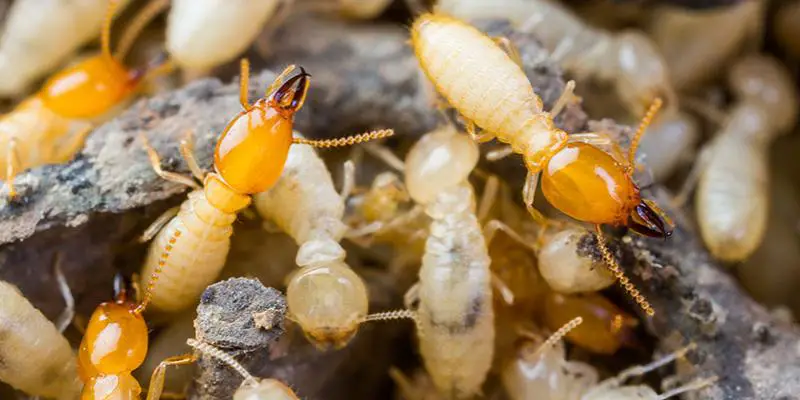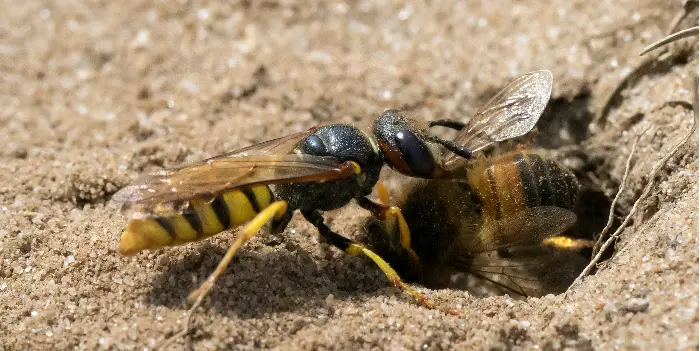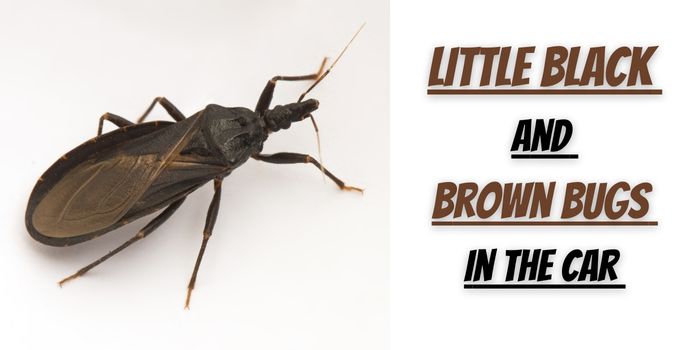
If you have an old vintage car or even a luxury car that you take care of, you may have noticed tiny black and brown bugs in your car.
Upon seeing them first, you may wonder why they’re actually present here, what they want to have, and how you can get rid of them.
Well, it all starts with knowing the type of bug first.
Because if you can’t figure out the type, you won’t be able to get rid of them easily, and they’ll just keep coming back.
Here in this article, I will attempt to help you identify the bugs, figure out why they’re in your car, and give some tips on how to get rid of them.
So, let’s start to dive in…
Small Bugs That can Live in Your Car
Bugs typically enter cars through open windows and can reside inside your car’s
stereo speakers, carpets, glove compartments, etc.
The length of time they stay usually depends on how hospitable their environment is in the car. If there are food crumbs or the car is dirty, bugs will be more likely to extend their stay.
However, most bugs only use cars for a short period of time; they crawl in and out opportunistically.
Spills from food and drinks are especially attractive to all types of bugs, like cockroaches and ants. But some others might even be drawn to organic matter, such as hair, nails, and dirt.
1- Ants in Electrical Systems
When ants are discovered inside automobiles, they are a major issue. They infest your car and might cause significant damage. Cars’ electrical systems, for example, may be damaged by fire ants very easily.
These ants have a dark red or brown body with the ability to sting. They are drawn to food and water in cars.
Many ants are foragers, which means they gather food instead of hunting it. They carry this food back to their nests.
Sugar is a big attractant for ants, so if you spill juice or any other sugary substance, you’re likely to see them swarming.
This is why it’s important to clean up spills immediately – otherwise, you’ll end up with an ant problem.
Ants may nest in a variety of places inside the automobile, making it more difficult to remove them. So, getting ants out of cars might only be accomplished using insecticide.
Although insecticide evaporates quickly, well-ventilated automobiles are required after the pesticide has been used because it is toxic to your health.
2- Bed Bugs in Car Seats
Bed bugs are among the most tenacious parasites you may encounter in a car.
They are small, brown, and oval-shaped. They bite humans, causing redness and itchiness in the affected area.
If you experience these symptoms after being in your car, check for bed bugs in the upholstered seats, they can hide there and begin to grow, particularly if they can bite people often.
Strong suction vacuum cleaners can remove most of them.
Keep in mind bed bugs are rarely transported into vehicles on their own – they are frequently transported into a vehicle by passengers with luggage or clothing.
3- Cockroaches Inside the Speakers
Cockroaches are characterized by their oval-shaped form. They usually have a flattened body structure with three pairs of legs and brown color.
Roaches use automobiles as shelter to lay eggs. Brown-banded cockroaches and German cockroaches are two common species that nest in cars.
Maintaining them out is just as difficult as maintaining them out of the house. These roaches can be prevented using regular cleaning.
4- Carpet Beetles in the Car Carpets
Carpet beetles infest cars in order to deface upholstery and seek refuge. These insects have white, yellow, and black oval-shaped bodies, and they typically enter vehicles by accident.
They might be carried on your person or clothing, especially if you already own them at home. And once they are in and if they find something to feed on, they will continue to live there.
Carpet beetles generally feast on wool, hair, dead insects, and even individual hairs.
Due to the places they often inhabit – cars specifically – various methods such as fumigation are used to get rid of them.
Thoroughly vacuuming the seats with a hot steam vacuum cleaner is also advisable to remove these bugs and their larvae from the car.
Some people use a combination of vinegar and water since carpet beetles don’t like that smell/taste.
5- Cicadas, Crickets, and Wasps in Engines
These insects are known to thrive even in hot and dry conditions, so they can easily hide inside your hot car engine.
Cicadas measure around 2-5 cm long, and their colors can be red, black, brown, or green. They have a unique body shape with large compound eyes.
Crickets, on the other hand, are black or dark brown and only grow up to 1.9 cm in length.
They are mainly drawn to cars because of the warmth that the engine emits. These insects can damage your car’s engine by chewing on the wires.
If you live in an area where cicadas and crickets are abundant, make sure to check your car’s engine regularly.
Wasps are naturally attracted to the heat emitted by cars. So, they will hover around the vehicle and sometimes even enter through open windows or air vents.
Some wasps think cars produce heat in a way that’s similar to animals and predators. That’s why you commonly also see wasps flying around the radiator, which is usually the hottest part of a car.
Wasps are quick to move when there is no food inside the vehicle. They will dwell in automobiles if they find roaches or other insects to feed on the inside, as is the case with unclean cars.
So, the best way to keep wasps out of your car is to keep it clean and free of food crumbs.
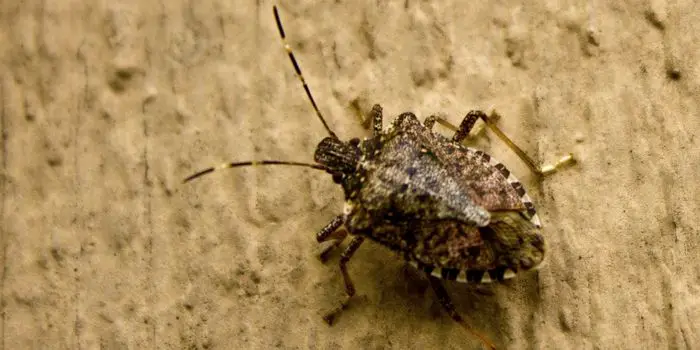
6- Fleas are Dangerous in Cars
Have you ever wondered why your car is always dirty? It could be because of fleas.
These dark-colored oval insects get inside cars from pets or people who carry them around in their clothing.
You need to take care not only for yourself but also for the safety and healthiness of those living near ya as these pesky pests pose quite a risk by biting humans on occasion – sometimes without even knowing it the first time around since they’re known blood feeders too (yikes!).
Cleaning out all areas where there might have been an infestation will help ensure that nothing is missed and all potential food sources are removed.
7- Fruit Flies and Horse Flies in the Glove Box
Horseflies are gray or brown, whereas fruit flies are dull tan to brownish-yellow in color.
Fruit flies are often found in kitchens near garbage cans or other places where there is rotting food. They can enter your car if you leave food out in the open or if you have garbage in the car.
Horseflies are often found near stables or other places where there are animals. They can enter your car if you have been around animals or if you have animal products in the car.
These insects are attracted to the warmth and moisture in the car. They can breed quickly and lay their eggs in the glove box or other areas of the car.
Spraying essential oils on automobiles is one of the most common ways to keep horseflies and fruit flies off your vehicle.
To keep horse flies and other insects out, many people use peppermint oil mixed with water. But other oils like lemongrass, eucalyptus, and cedarwood are effective as well.
8- Spiders and Spider Web In Cars
Spiders enter cars in search of food or by chance as they spin webs under seldomly used vehicles.
You can encounter spiders in your car when you park near woodlands, bushes, trees, or firewood where spiders typically reside.
Some spiders (both poisonous and non-poisonous) are found in cars that don’t often move, while others may also be found in well-traveled vehicles.
Keep in mind that spiders make webs in uncleaned cars mostly to catch insects. So, if you spot a spider web in your car, it means there are also other insects present.
You can prevent spiders from entering your car by regularly cleaning it and by using spider repellent.
9- Weevils, Earwigs, and Thrips In Lights
Weevils are small, brown, winged insects, whereas earwigs are black, winged insects. Both of these insects are attracted to light – so they are often seen in the headlights of a car.
Weevils and earwigs enter cars through open doors and windows, through cracks and crevices.
To keep these insects off your cars, switch off the lights when the car is not in use and regularly clean the area around the headlights.
Thrips are a bit different because these tiny insects are attracted to bright colors.
So, it’s best to cover your bright-colored car with a dark-colored cloth when not in use to keep thrips away.
Plants like lavender, peppermint, and eucalyptus have oils that naturally keep bugs at bay. Pots full of these plants can be placed near the parking space or garage to prevent various insects from entering your car.

7 Easy Ways to Getting Bugs Out of Your Car
Because of their infinitesimal quantities, bugs might hide for extended periods in vehicles before being detected.
If you know how they’re getting in, what are the signs of their presence, and where they exactly are, there are a few easy ways that you can get these bugs out of your car quickly.
Here are some of the most common ones:
1. Use a Vacuum
If you have a handheld vacuum or an attachment for your regular vacuum, this can be a quick way to remove bugs from your car.
Just be careful not to damage any upholstery or surfaces in your car while you’re vacuuming.
2. Use a Tape
Another quick way is to use tape. You can either use duct tape or packing tape to trap bugs and then peel them off.
This method is particularly effective for small insects. It works by sticking the small insects which you can later dispose of easily away from your vehicle.
Just like tapes, a lint roller is another quick and easy way to remove bugs from your car – roll it over any surfaces where you’ve seen bugs and they’ll stick to the adhesive.
3. Use an Insecticide
If you have a serious infestation, you may need to resort to using an insecticide.
You can either spray it around the perimeter of your car or inside it to kill any bugs that are already there.
These can be effective at killing bed bugs and other insects, but they can also be dangerous to use.
So, just be sure to read the label carefully and follow the instructions before you use these spray bug repellants inside your car.
4. Chlorine Bug Bombs
Chlorine bug bombs are an effective way to get rid of bugs in your car as well as at home. The bombs release a gas that kills bugs on contact.
To use them, simply place the bomb in the affected area and set it off. The gas will spread throughout the vehicle, killing any bugs it comes into contact with.
Bug bombs are most effective when used in enclosed spaces. This allows the gas to build up and reach a higher concentration, which increases its effectiveness.
When using bug bombs, be sure to follow the directions carefully and evacuate the area immediately after setting off the bomb.
5. Use a Steamer
A steamer can also be effective in getting rid of bugs in your vehicle. Particularly if they are bed bugs you can effectively use the cloth steamer to your advantage.
Be careful not to damage any vehicle’s surfaces (like your expensive leather seat) while you’re using it to get rid of bugs.
6. Baits and Traps
There are a number of different traps and baits to get rid of insects in the car. Some of the most popular include:
- Terro T1400-6 Multi-Surface Liquid Ant Baits
- Combat roach gel
- Maxforce roach gel bait
- Hotshot no-pest strips
- Raid ant and roach killer
- Raid Concentrated Deep Reach Fogger
These are just a few of the many different products that are available to help you get rid of insects in your car. Be sure to read the labels carefully and follow the directions to ensure that you are using them correctly.
7. Try Home Remedies
Spices such as pepper, cloves, and cinnamon can help to repel insects. You can either sprinkle them around the perimeter of your car or place them inside bags and place them inside your vehicle.
Another home remedy that can help to keep insects away is lavender oil. You can either place a couple of drops on a cotton ball and place it inside your car or add it to a diffuser.
The third natural way is to use vinegar. You can either place a bowl of vinegar inside your vehicle or soak a cloth in vinegar and wipe down the surfaces of your car.
You can also try a combination of these home remedies but if you have a serious infestation, and have tried various methods listed above, you may need to call in a professional exterminator.
They will be able to identify the type of bugs you have and get rid of them quickly.
Can Bugs Damage the Car’s Interior and Electronics?
While bed bugs are not known to damage the interior of your car or any of your electronics, other insects can.
For example, cockroaches and fire ants can damage wiring and other electronics if they infest your expensive Ford car.
This can be a serious problem because it can cause your vehicle to malfunction or even catch fire just in case, they happen to reach the engine through vents.
Insects can also damage the upholstery of your car, mirrors, windshields, etc. leaving behind unsightly stains.
If you have an infestation of any kind, it’s important to get rid of the insects as soon as possible to prevent further damage.
But remember, the best way to deal with bugs in your car is to prevent them from getting in there in the first place.
Make sure to keep your windows closed and check for any holes or cracks where they could be getting in.
Depending on the nature of the holes, gaps, and openings, you can use chemical sealants such as glue, acrylic caulking, and others.
As a preventive measure, you can also try using insecticide for bugs and spiders around the perimeter of your car to keep them away.
To stop the insects from getting in your car you can also try these prevention tips…
- Keep your vehicle clean – wash and vacuum it regularly
- Do not leave your vehicle lying idle for a very long in the same place
- Use air fresheners or essential oils to keep the insects away
- Check your vehicle for any insects before driving it, if they are present wash them off
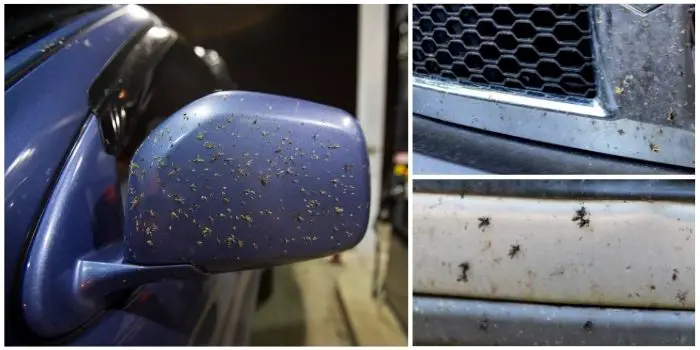
How Do You Remove Old Dried Bugs and Stains from Car?
When bugs land on your car’s hood, the grills, and behind the mirrors (the most typical landing spots, along with the windshield) they start making it look dirty and if it isn’t cleaned off straight away, issues might arise.
Most of them also release bug spatter, which is acidic and includes compounds that may eat through a clear coat in two days, destroying the paint on your vehicle and producing pockmarks.
Removing the bugs from the car exterior is, therefore, most important and should be done on time.
Before covering the different ways to remove dried insects and stains, one thing to always keep in mind is always attempting to remove them before they stick and get dried on the surface. Because that can damage the car finish forever.
Method 1: Microfiber Cloth and Spray Wax
These are two of the safest products to eradicate bugs from the car exterior.
Microfiber towels are specifically engineered to take up wax and other materials, making them an efficient and risk-free solution.
Just spray the wax on the vehicle spot where love bugs have affected the surface and wipe it away.
Also, spray some of the wax on the wiping cloth and proceed in one direction when removing contaminants using any of these procedures.
You just want to take these insect particles off your automobile, without working in circles, which might cause scratches.
Method 2: Car Detergents and Bug Removal Sponge
Method 2 is probably your best DIY bug remover if the microfiber towel is unable to remove all of the bugs from your car’s surface.
To make a homemade car bug remover take a bucket and fill it half with vehicle soap and water. Then with a bug removal sponge clean the surface.
These sponges are available in almost any place and feature a rough surface that makes them ideal for removing stuck-on contaminants and bug stains.
Before rubbing the sponge over the surface, ensure you give it a good squeeze and get the extra soap out.
Now, apply it to the affected area or where the bugs have dried out with ugly stains.
Ensure that the sponge is adequately lubricated, or otherwise, it may cause minor scratching.
Allow the removal solution to stay for about 30 seconds before wiping it away with a microfiber cloth.
Method 3: Citrus-Centric Degreasers & Bug Removers
Citrus-centric degreasers are also effective against difficult-to-remove pests stuck on your car surface.
These are environment-friendly degreasers that are suitable for cleaning dead bugs off clear coatings.
It’s also good for decomposing organic substances such as bird droppings.
You can find plenty of bug cleaner sprays (like bug be gone for cars) that aids in the removal of bugs and stains.
The only thing is they need to be sprayed carefully.
After using this sort of treatment, you should wash your automobile as usual to eliminate any stains that may have been left behind.
Besides degreasers, there are also cleaning solutions that can be poured directly into the wash reservoir of your car.
These aid in the breakdown of dead insect guts to increase visibility when they are spatter on your windshield.
Different Ways to Prevent Bugs from Sticking to Your Car Body
When it comes to preventing bugs from sticking and damaging a car’s white paint, certain products/films help a lot.
Especially if you have fresh wet paint on your car or a truck these strategies will be effective in keeping the bugs off.
So, here are the 5 best ways:
1: Wax it
The primary function of car wax is to protect your vehicle’s clear coat and it’s one of the best ways of insect prevention on your car surface.
IMO, it’s an excellent practice to have it on your car at all times as its major role is to make clean-up easier by establishing a shield between your car and rain, pests, or any outside factors.
After you’ve gotten rid of those dried insects from your car and washed the surface properly, apply a thorough coat of wax to places like your hood and bumper.
2: Apply Bug Barricade
This is a liquid bug-repellent compound that provides a slick surface suitable for off-road vehicles.
After cleaning and drying your car, just spray it on and distribute it evenly throughout the surface with a microfiber cloth or sponge.
Unlike waxes and polishes, this substance forms an impenetrable layer to keep bugs off your clear coat.
But remember it is not very long-lasting and is only supposed to last a few weeks. So, it’s an ideal solution if you are taking your car for hunting or other outdoor activities.
3: Use Bug Protection Shield
These shields are attached to your car, which keeps bugs away.
These shields come in a variety of forms and sizes and are normally attached to the car using tape.
If your vehicle stays in outdoor areas, these will do an amazing job.
4: Apply a Paint Protection Wrap
Applying a paint protection wrap to your car is another temporary but very useful solution to keep bugs off your luxury car.
If you’re concerned about paint damage or etching due to bugs these wraps can be very effective.
Plus, these car wraps are intended to block the damage due to hitting tiny pebbles and may be a great alternative if you want to keep your paint looking incredible all the time.
The only downside is these must be reapplied over time, but they are ideal if you want to protect the outside of your automobile for as long as possible.
A pro tip: For infrequent weekend travels when you will be off-roading or in a location where insects are abundant, apply some wraps to the hood of the car, bumper, and side-view mirrors.
Just be a bit careful that you don’t let these wraps attached to the car’s surface for a longer period of time.
5: Use Windshield Protection to Keep Bugs Off
This is helpful if you live in an area where you are unable to park your car in a garage at night time.
You can make use of the windshield cover that will prevent the insects from sitting and polluting, which will help you have a clean and clear windshield in the morning.
The Conclusion
Ants, wasps, beetles, and many more get attracted to your car so that they can find their way in.
They will first try to stick to the windshield, doors, windows, etc. And then can slowly drag inside.
Some of them can die on the surface and can leave stains that are hard to remove.
Although it’s hard to avoid some bug gunk on your car, there are certain things you can do to keep it looking excellent.
Follow the steps outlined above to keep the bugs off your car, make the cleaning process easy, and maintain your car like a pro.
Share the post "Little Black and Brown Bugs in the Car – Why are They Here?"

Welcome to ProShieldPest.com. I am Tina Jones. I have been working as a pest removal professional in Winslow, Arizona lately. At present, I love to spend my time with my family as a retiree.
Here I share all my knowledge and experiences to help people understand better how they can stop pests at their homes without actually killing them. Hopefully, the information you will find here will help in safeguarding your home! You can check more about me here.

